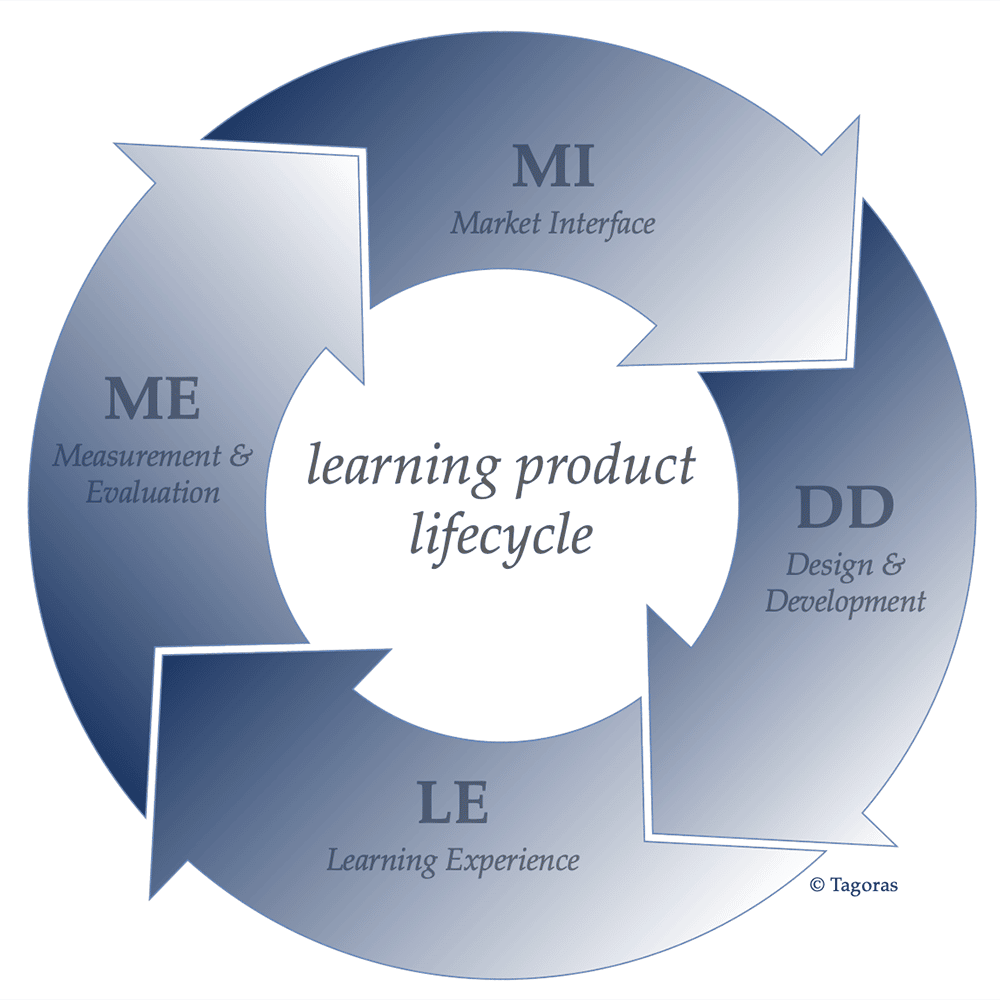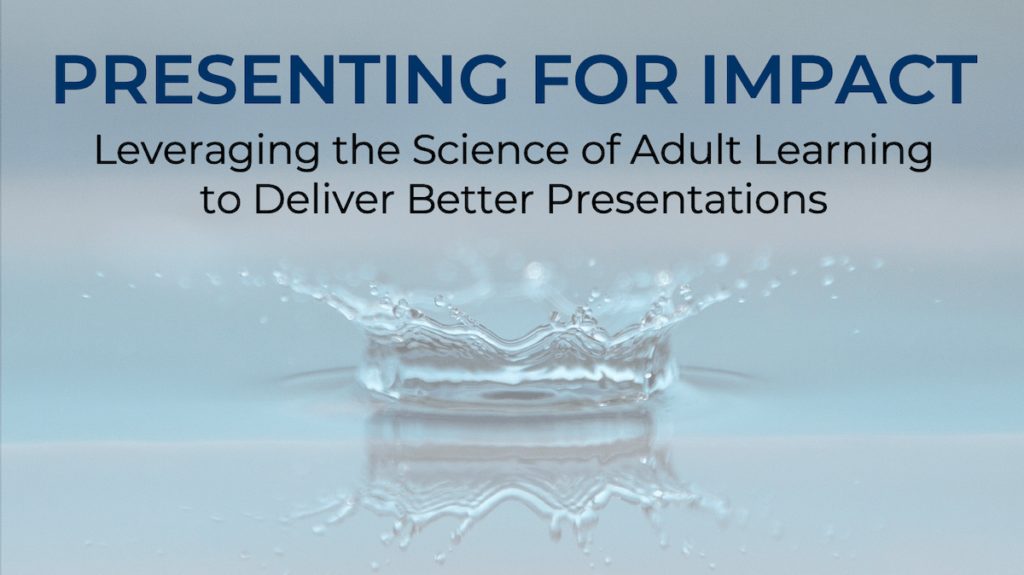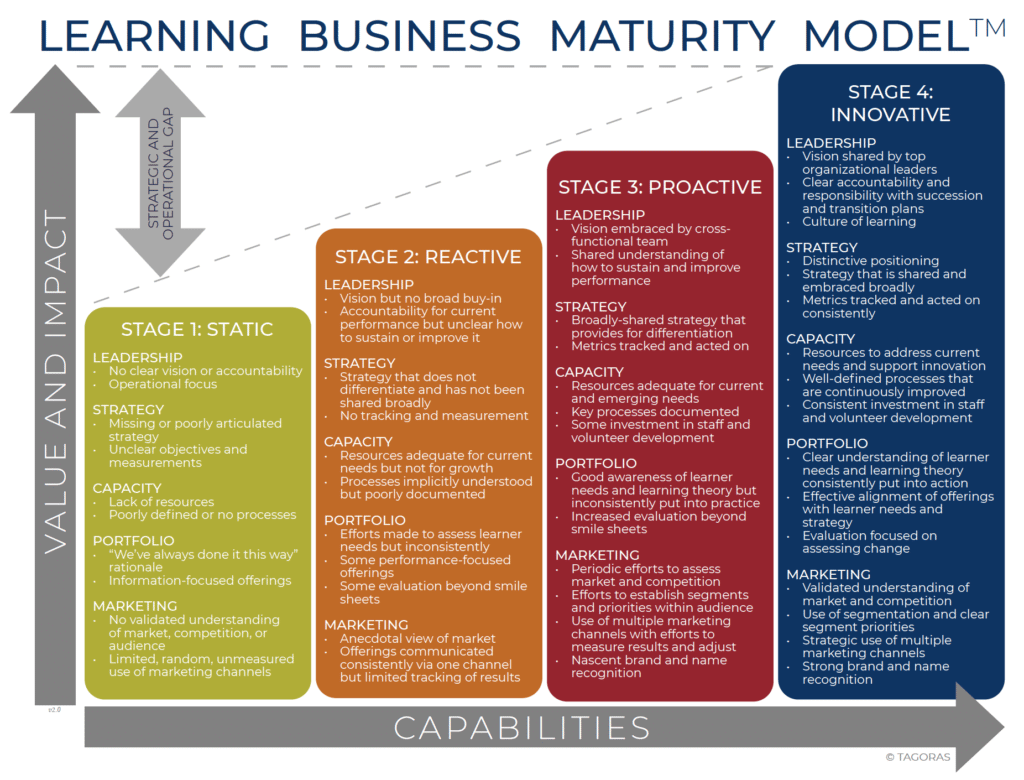Too often learning businesses think too much about the end product without considering all the phases in the learning product lifecycle. By focusing too much on the end result, there’s a missed opportunity in producing the best product possible.
In this fourth episode in our informal series on tools for learning businesses, we highlight the MIDDLE ME learning product lifecycle. We break down the four components of MIDDLE ME—market interface (MI), design and development (DD), learning experience (LE), and measurement and evaluation (ME)—and explain how and why to use it to help you grow your learning business.
To tune in, listen below. To make sure you catch all future episodes, be sure to subscribe via RSS, Apple Podcasts, Spotify, Stitcher Radio, iHeartRadio, PodBean, or any podcatcher service you may use (e.g., Overcast). And, if you like the podcast, be sure to give it a tweet.
Listen to the Show
Access the Transcript
Download a PDF transcript of this episode’s audio.
Read the Show Notes
[00:00] – Intro
Why Use MIDDLE ME?
[01:11] – MIDDLE ME is a framework for thinking about the full lifecycle of any learning product. Too often we think too much about the end product without considering all the phases in the lifecycle. The end product is just one part of the lifecycle.
MIDDLE ME expands our thinking about learning products, making it clear that we should start with understanding market needs and continue through looking at the results we get from a product once it’s being used by learners in the market.
If you don’t take the big-picture lifecycle view, you risk building it, and they don’t come, or enough don’t come, and we risk not understanding why a product is failing if we aren’t baking in measurement and evaluation.
Celisa Steele
On the one hand, MIDDLE ME expands our thinking beyond the end product itself. But it can also focus our attention by giving us four buckets to focus on, the four phases of the lifecycle:
- Market interface (MI), where you seek to understand what your learners need and want and communicate with them about the value you have to offer
- Design and development (DD), where you create what your learners need and want
- Learning experience (LE), where the learners actually interact with what you’ve created
- Measurement and evaluation (ME), where you look at the impact of learners interacting with what you’ve created
Having those four areas defined helps you pay attention to the entire lifecycle and gives you some guidance for doing that by breaking the lifecycle down.
Partner with Tagoras
[03:37] – At Tagoras, we’re experts in the global business of lifelong learning, and we use our expertise to help clients better understand their markets, connect with new customers, make the right investment decisions, and grow their learning businesses.
We achieve these goals through expert market assessment, strategy formulation, and platform selection services. If you are looking for a partner to help your learning business achieve greater reach, revenue, and impact, learn more at tagoras.com/services.
What Is MIDDLE ME?
[04:12] – MIDDLE ME is a process visual that depicts the four phases of the learning product lifecycle.
The arrows pointing from each segment to the next are an important aspect. This isn’t a linear process; it’s a circular one, where what you learn in each phase ideally informs and shapes what you do in the next phase.
In the market interface phase, you learn about what the market needs, wants, and already has, which should feed into the next phase, design and development. You want to design and develop products that address a market need or want.
Then how you design and develop a product is very directly going to influence the learning experience that learners participate in. In design and development, you’ll decide a ton of things about the format that will determine a lot about the learning experience that individual learners have.
Delivery and facilitation also are factors in LE. How do you contextualize what you have designed and developed to maximize engagement and relevancy? Technology comes into play throughout MIDDLE ME, but it often plays a front-and-center role in LE. Your learning platform and related tools are going to make participation in online learning experience possible and effective.
Measurement and evaluation look at the impact of learners interacting with what you designed and developed. Often what’s measured and evaluated are things that happened during the learning experience phase, activities like assessments and course evaluations.
Ideally, your ME efforts will also look longer term to how your product or service has changed performance and possibilities for the learner and, where relevant, her organization/employer. It should also consider the impact on your organization. Measure and evaluate how the product or service has impacted your position in the market, how you’re perceived, and the demand for your offerings.
[07:30] – Measurement and evaluation then feed back into the market interface, ideally, continuing the circle. Many learning businesses focus too exclusively on the end product but even when they broaden the focus to include other phases of the lifecycle, there can be the tendency to treat this as a linear process rather than a circular one.
Don’t forget to use what you learn in each phase to improve your understanding of the market and what they offer. Your measurement and evaluation findings can give you added information to use during market interface.
If a product didn’t get the traction you expected or hoped for, why not? Is a product doing better than expected, in terms of ratings or uptake? That data can become part of how you better understand your market and what learners need and want.
Also, note that MIDDLE ME works well with a science-based approach to learning. Learning science is about being evidence-based and data-driven and MIDDLE ME helps ensure you have a diversity of data and evidence to draw on at each phase of the learning product lifecycle.
Market Interface (MI)
Market interface is all about knowing and connecting with your audience—your learners and customers and your potential learners and customers. To help make sure you really know what the market needs and wants—and don’t just think you know—you’ll want to use science-backed approaches.
You can use learner needs assessments and market assessments to provide evidence and data of what the market needs and wants. Then once you have evidence and data, make sure to share that with your designers and developers.
Design and Development (DD)
[09:31] – That’s because the next phase, design and development, is where those designers and developers are going to plan and create the products that your learners need and want. This helps them choose appropriate learning science-based approaches that match market need. Cutting and chunking to help with the limitations of working memory will always be important. But other aspects can be guided by market wants—for example, whether to include practice and, if yes, how much.
The main players involved in this design and development phase are the people doing the design and development of your learning experiences. If you are lucky enough to have instructional designers on staff, then they’ll usually know evidence-based, science-backed approaches to use.
If, however, you rely heavily on volunteers or subject matter experts, then your work may be a little harder. You may have to spend some time figuring out how do you get those people up to speed on some of the key aspects of learning science and what makes for an effective adult learning experience because many of them will have subject matter expertise, but they may not have that grounding in learning science and adult learning.
Presenting for Impact
[10:55] – That’s the reason that we created “Presenting for Impact,” free training for experts who are charged with presenting at conferences, continuing education Webinars, etc. It helps those people put learning science to practical use as they are both developing and then delivering learning experiences.
Our experience has been that subject matter experts are often very well attuned to the market, so they’re tuned in to the market interface phase. They’ve got a sense of what’s going on out there because they’re usually part of the market themselves—but they need some help in the design and development phase and using learning science effectively.
Professional instructional designers, on the other hand, often know the learning science, and they get the design and development phase because that’s the lion’s share of what they do, day in and day out. But often learning businesses need to make sure that the IDs are really tuned into the market interface phase and translate that into DD.
See related episodes about learning science in our series “Learning Science for Learning Businesses.”
The Learning Experience (LE)
The next phase, learning experience, is where the rubber meets the road. It’s where learners interact with what you’ve designed and developed based on your market interface. Mostly you have to make sure that good design and development doesn’t get thwarted.
This is also where feedback and practice happen, and getting those aspects right can be tricky. You need to ensure your presenters, facilitators, and instructors understand the importance of feedback and know how and when to give appropriate feedback.
Measurement and Evaluation (ME)
[13:14] – This is the fourth of four phases and it’s where we look at the impact of learners interacting with what we’ve designed and developed. This is where we measure and evaluate products and services, and we always want to do that with an eye to what business insights we can glean.
So, look at quantitative data and qualitative data. Course ratings, completion rates, success cases you might find using Brinkerhoff’s Success Case Method, open-ended feedback on end-of-class surveys, etc. Then leverage that information and insight.
The data and evidence you collect can help you to refine and improve what you offer, find new things to offer, and identify products you need to sunset because they aren’t as effective as you’d expected.
To succeed as a learning business, what you deliver does have to be effective. It has to get the learners where they need to go, and using MIDDLE ME can help make that happen for your learning business.
Celisa Steele
How to Use MIDDLE ME?
[14:29] – We’ve talked about why and what, so now let’s turn to how to use MIDDLE ME.
As with many of the tools we’ve already discussed in this informal series of tool talks, simply putting the visual up in a team meeting and discussing the lifecycle can elicit meaningful conversation. You might discuss which phases you’re strong in, which phases you’re weaker in, what you’re doing in each phase, and what else you might do in each phase.
Process visuals, like MIDDLE ME, are simple but powerful conversation starters because they provide common language and a common point of reference. MIDDLE ME can be a great discussion starter, and you can also use it to assess your capacity as a learning business. Capacity means the people, processes, and technology you have in place.
Capacity is also one of the five domains we focus on in the Learning Business Maturity Model.
To learn more about the Learning Business Maturity Model, check out these episodes:
- Maturity, Learning, and Desired States
- Leveraging the Learning Business Maturity Model
- Revisiting the Learning Business Maturity Model
- The Learning Business Maturity Model
Simply listing the phases of the learning product lifecycle will invite you to think about what capacity you have in each phase. What technology and processes do you have in place for the four phases? What human resources and budget? Where do you need to invest more, whether that’s hard dollars or additional staff time and staff training?
You might use tools like the Market Insight Matrix and survey technology—SurveyMonkey, Qualtrics, etc.—in the market insight phase. Maybe you have a data analyst you can access to help with interpreting survey data. Maybe you have a market research firm you contract with to annually assess your audiences.
Making sure everyone on the team is aware of what you have can (a) make sure you make good use of what you have in place and (b) help you see areas where you may need additional help, whether in the form of people, processes, or technology.
In each of the four phases, you can inventory what you have in place in general. That’s using MIDDLE ME at the enterprise, learning-business level. But you can also use MIDDLE ME to evaluate individual products or product lines. It can serve as a high-level checklist to help ensure you’re thinking about all four phases when creating and maintaining your products.
It’s a reminder that you should have people, processes, and technology in place in each phase—and you should be using those people, processes, and technology. You likely have a learning management system (LMS) in place to help you with delivering learning experiences, the LE phase. But also think about the data you can get from your LMS that can help you in the ME, measurement and evaluation, phase.
People, processes, and technology often get used in multiple phases. For example, an LMS can arguably influence all four phases.
The same is often true for people and processes—they won’t reside wholly in single phase. They’ll tend to work in more than one phase, sometimes all four. An instructional designer, for example, will focus the majority of their time in design and development, but, by virtue of their role in designing assessments, they touch on measurement and evaluation too.
It’s worth thinking about the four phases when thinking about your capacity. You may already have technology, processes, and/or people in place, and you just need to expand how and when you make use of them.
[18:55] – Wrap-up
To make sure you don’t miss new episodes, we encourage you to subscribe via RSS, Apple Podcasts, Spotify, Stitcher Radio, iHeartRadio, PodBean, or any podcatcher service you may use (e.g., Overcast). Subscription numbers give us some data on the impact of the podcast.
We’d also be grateful if you would take a minute to rate us on Apple Podcasts at https://www.leadinglearning.com/apple or wherever you listen. We personally appreciate reviews and ratings, and they help us show up when people search for content on leading a learning business.
Finally, consider following us and sharing the good word about Leading Learning. You can find us on Twitter, Facebook, and LinkedIn.
Episodes on Related Topics:






 The What and Why of xAPI with Megan Torrance
The What and Why of xAPI with Megan Torrance
Leave a Reply